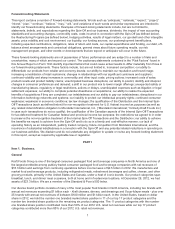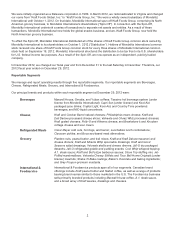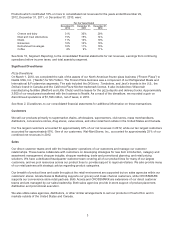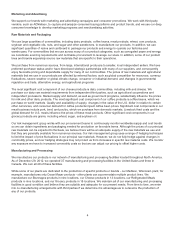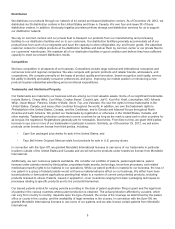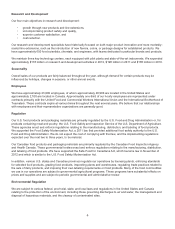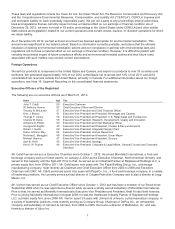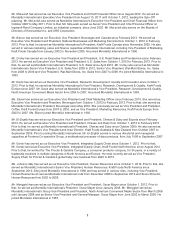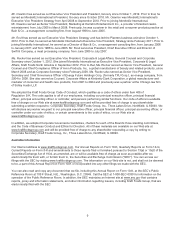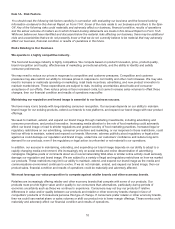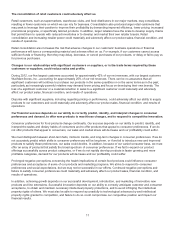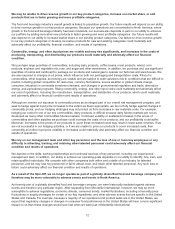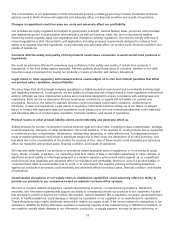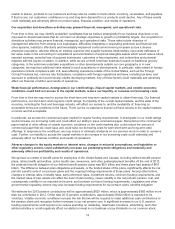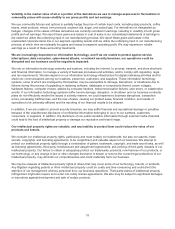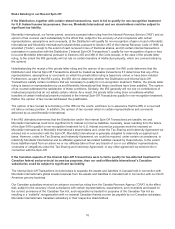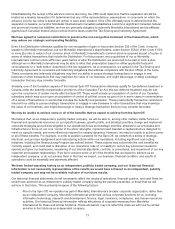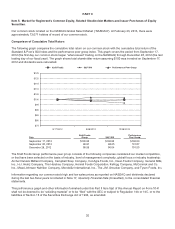Kraft 2012 Annual Report Download - page 13
Download and view the complete annual report
Please find page 13 of the 2012 Kraft annual report below. You can navigate through the pages in the report by either clicking on the pages listed below, or by using the keyword search tool below to find specific information within the annual report.The consolidation of retail customers could adversely affect us.
Retail customers, such as supermarkets, warehouse clubs, and food distributors in our major markets, may consolidate,
resulting in fewer customers on which we can rely for business. Consolidation also produces larger retail customers that
may seek to leverage their position to improve their profitability by demanding improved efficiency, lower pricing, increased
promotional programs, or specifically tailored products. In addition, larger retailers have the scale to develop supply chains
that permit them to operate with reduced inventories or to develop and market their own retailer brands. Retail
consolidation and increasing retailer power could materially and adversely affect our product sales, financial condition, and
results of operations.
Retail consolidation also increases the risk that adverse changes in our customers’ business operations or financial
performance will have a corresponding material and adverse effect on us. For example, if our customers cannot access
sufficient funds or financing, then they may delay, decrease, or cancel purchases of our products, or delay or fail to pay us
for previous purchases.
Changes in our relationships with significant customers or suppliers, or in the trade terms required by these
customers or suppliers, could reduce sales and profits.
During 2012, our five largest customers accounted for approximately 42% of our net revenues, with our largest customer,
Wal-Mart Stores, Inc., accounting for approximately 25% of our net revenues. There can be no assurance that all
significant customers will continue to purchase our products in the same quantities or on the same terms as in the past,
particularly as increasingly powerful retailers may demand lower pricing and focus on developing their own brands. The
loss of a significant customer or a material reduction in sales to a significant customer could materially and adversely
affect our product sales, financial condition, and results of operations.
Disputes with significant suppliers, including regarding pricing or performance, could adversely affect our ability to supply
products to our customers and could materially and adversely affect our product sales, financial condition, and results of
operations.
Our financial success depends on our ability to correctly predict, identify, and interpret changes in consumer
preferences and demand, to offer new products to meet those changes, and to respond to competitive innovation.
Consumer preferences for food products change continually. Our success depends on our ability to predict, identify, and
interpret the tastes and dietary habits of consumers and to offer products that appeal to consumer preferences. If we do
not offer products that appeal to consumers, our sales and market share will decrease and our profitability could suffer.
We must distinguish between short-term fads, mid-term trends, and long-term changes in consumer preferences. If we do
not accurately predict which shifts in consumer preferences will be long-term, or if we fail to introduce new and improved
products to satisfy those preferences, our sales could decline. In addition, because of our varied consumer base, we must
offer an array of products that satisfy the broad spectrum of consumer preferences. If we fail to expand our product
offerings successfully across product categories, or if we do not rapidly develop products in faster growing and more
profitable categories, demand for our products will decrease and our profitability could suffer.
Prolonged negative perceptions concerning the health implications of certain food products could influence consumer
preferences and acceptance of some of our products and marketing programs. We strive to respond to consumer
preferences and social expectations, but we may not be successful in our efforts. Continued negative perceptions and
failure to satisfy consumer preferences could materially and adversely affect our product sales, financial condition, and
results of operations.
In addition, achieving growth depends on our successful development, introduction, and marketing of innovative new
products and line extensions. Successful innovation depends on our ability to correctly anticipate customer and consumer
acceptance, to obtain and maintain necessary intellectual property protections, and to avoid infringing the intellectual
property rights of others. We must also be able to respond successfully to technological advances by and intellectual
property rights granted to competition, and failure to do so could compromise our competitive position and impact our
financial results.
11


